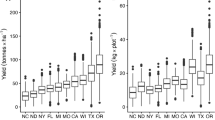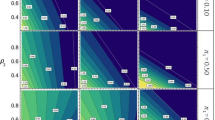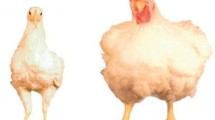Summary
Two simulated data sets, representing random mating and positive assortative mating in a beef cattle population over 10 rounds of mating, were each composed of 100 replicates. Three correlated traits were considered; calving ease (CE), 200 day weight (WW) and postweaning gain (PG). All selection practiced in the simulation was random. Positive assortative mating, which was based on parental WW phenotypic records, increased the progeny additive genetic variance of WW. The absolute values of genetic covariances and correlations between WW with CE and PG were also increased by positive assortative mating. Variances or covariances did not reach their expected equilibrium values due to overlapping generations, low replacement rates and only 10 rounds of mating.
Similar content being viewed by others
References
Bulmer MG (1971) The effect of selection on genetic variability. Am Nat 105:201–211
Bulmer MG (1980) The mathematical theory of quantitative genetics. Clarendon Press, Oxford
Crow JF, Felsenstein J (1968) The effect of assortative mating on the genetic composition of a population. Eugen Q 15:85–91
Forsythe GE, Malcolm MA, Moler CB (1977) Computer methods for mathematical computations. Prentice Hall, Englewood Hills Calif
Gianola D (1982) Assortative mating and the genetic correlation. Theor Appl Genet 62:225–231
Goult RJ, Hoskins RF, Milner JA, Pratt MJ (1974) Computional methods in linear algebra. Wiley and Sons, New York NY
IMSL (1979) International Mathematics and Statistics Library
Jennings HS (1916) Numerical results of diverse systems of breeding. Genetics 1:53–89
Lush JL (1948) The genetics of populations. Iowa State University, Ames, Iowa
Statistical Analysis Service (1979) SAS users guide. SAS Institute, Cary NC
Schaeffer LR, Wilton JW (1981) Estimation of variances and covariances for use in a multiple trait beef sire evaluation model. Can J Anim Sci 61:531–538
Schaeffer LR (1982) Notes on linear model theory and best linear unbiased prediction. University of Guelph, Guelph, Ontario
Sorensen DA, Kennedy BW (1984) Estimation of response to selection using least-squares and mixed model methodology. J Anim Sci 58:1097–1106
Wentworth EN, Remick BL (1916) Some breeding properties of the generalized Mendelian population. Genetics 2:608–616
Wright S (1921) Assortative mating based on somatic resemblance. Genetics 6:111–178
Author information
Authors and Affiliations
Additional information
Communicated by L. D. Van Vleck
The financial assistance of Agriculture Canada and the Natural Sciences and Engineering Research Council of Canada are gratefully acknowledged
Rights and permissions
About this article
Cite this article
Kemp, R.A., Kennedy, B.W. & Wilton, J.W. The effect of positive assortative mating on genetic parameters in a simulated beef cattle population. Theoret. Appl. Genetics 72, 76–79 (1986). https://doi.org/10.1007/BF00261458
Accepted:
Issue Date:
DOI: https://doi.org/10.1007/BF00261458




